 |
 |
 |
| |
Virologic Responses to Peginterferon Alfa-2a/Ribavirin in Treatment-Naive Latino vs Non-Latino Whites Infected With HCV Genotype 1: The LATINO Study
|
| |
| |
Reported by Jules Levin
Presented in poster at EASL April 200, Milan
M. Rodriguez-Torres, MD1; L.J. Jeffers, MD2; M.Y. Sheikh, MD3; L. Rossaro, MD4; V. Ankoma-Sey, MD5; F.M. Hamzeh, MD, PhD6;
P. Martin, MD7; on behalf of the LATINO Study Group
1Fundacion de Investigacion de Diego, San Juan, Puerto Rico; 2Miller School of Medicine, University of Miami, Miami, FL; 3University of California San Francisco Fresno Educational Program, Fresno, CA;
4University of California-Davis Medical Center, Sacramento, CA; 5University of Texas Medical School and St. Luke's Episcopal Hospital Center for Liver Disease, Houston, TX; 6Roche, Nutley, NJ;
7Mount Sinai Medical Center, New York, NY
CONCLUSIONS
SVR after 48 weeks of treatment with peginterferon alfa-2a plus ribavirin was higher in HCV genotype-1 infected non-Latino white patients than in Latino patients
More patients required ribavirin dose reduction than peginterferon alfa-2a dose reduction. There were no differences between groups in the proportion of patients requiring dose reduction for either peginterferon alfa-2a and ribavirin
Combination therapy with peginterferon alfa-2a plus ribavirin was generally safe in both populations with the expected number of adverse events reported. There were no differences in the percent of withdrawals among the groups for safety reasons. Latino patients had more withdrawals than non-Latino white patients for
non-safety reasons-mostly owing to insufficient response
Our data support the need for additional strategies to improve SVR in Latinos
RESULTS
SVR was higher in the non-Latino group than in the Latino group (49.3% vs 33.5%; P<.0001)
HCV RNA undetectability rates in the non-Latino vs Latino groups over time were: week 4, 20% vs 13.8% (P<.05); week 12, 63% vs 48% (P=.0003); week 24, 73.3% vs 59.5% (P=.0004); week 48, 72.7% vs 56.1% (P<.0001)
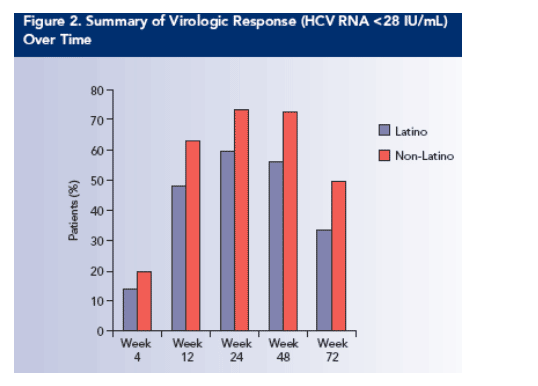
Patient Characteristics and Demographics
The study enrolled 269 Latino whites and 300 non-Latino whites. Countries of origin of Latino whites are shown in Figure 1
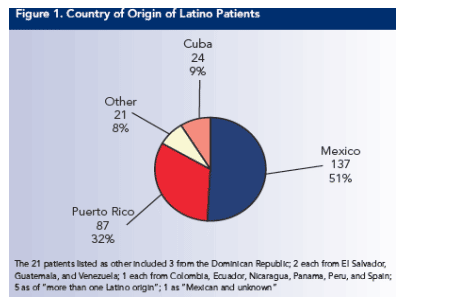
Baseline characteristics of both groups are shown in Table 1
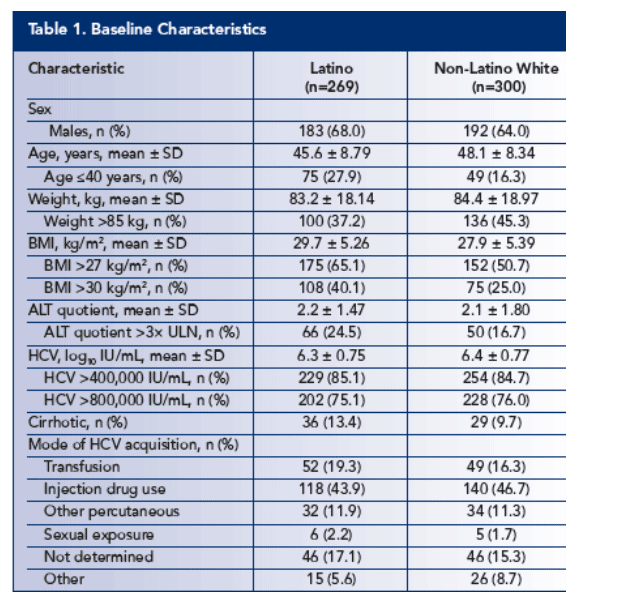
Higher percentage of the Latino group were ≦40 years old (27.9% vs 16.3%)
Higher percentage of the Latino group had a higher body mass index (BMI) than the non-Latino group: BMI >27 kg/m2 (65.1% vs 50.7%) and >30 kg/m2 (40.1% vs 25.0%)
Percentage of patients with ALT quotient >3°- ULN was higher in the Latino group than in the non-Latino group (24.5% vs 16.7%)
Percentage of cirrhotic patients was higher in the Latino than in the non-Latino group (13.4% vs 9.7%), despite limiting the percent enrolled to ensure comparable patient characteristics
Factors Associated With SVR
Low baseline HCV RNA (≦400,000 IU/mL ) predicts SVR in both Latino and non-Latino patients
Cirrhotic status predicts SVR in the Latino group
Male sex predicts SVR in the non-Latino group
Low ALT (≦3°- ULN) predicts SVR in Latino patients while high ALT (>3°- ULN) predicts SVR in non-Latino patients
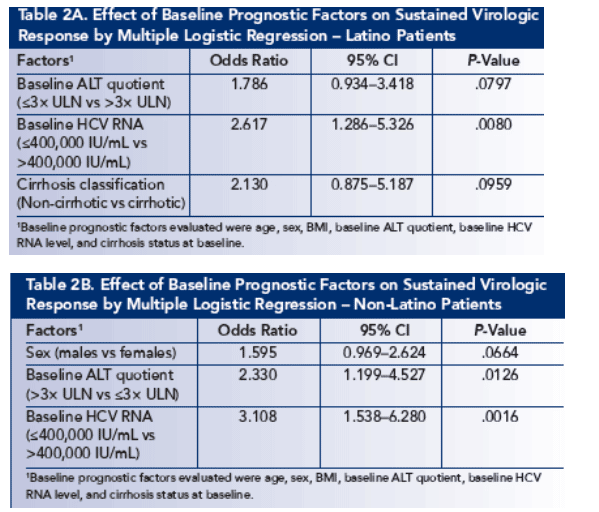
Dose Modifications
The data suggest that the number of patients that required ribavirin and peginterferon alfa-2a dose modifications was similar in Latino and non-Latino groups (35.3% vs 35.7% and 23.4% vs 26.7%, respectively)
The difference in total doses received did not explain the difference in SVR between Latino and non-Latino patients
The proportion of patients who required ribavirin dose reduction seemed to be greater than the proportion of patients who required peginterferon alfa-2a dose reduction (35.3% vs 23.4% in the Latino group; 35.7% vs 26.7% in the non-Latino group)
SAFETY
Overall, treatment withdrawals for the Latino and non-Latino white group were similar; 29% and 25%, respectively (Table 3)
In the Latino population, 9% of patients were withdrawn due to safety-related adverse events and 20% due to non-safety related issues; including 9% for insufficient response. In the non-Latino population, withdrawals due to safety-related adverse events were 14% and 11% due to non-safety related issues, including 4% for insufficient response
The number of withdrawals for both safety and non-safety reasons did not help to explain the difference in SVR
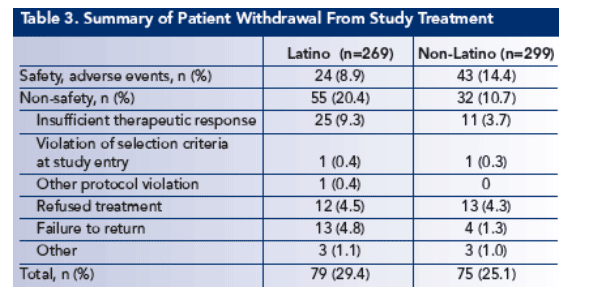
INTRODUCTION
Latinos have been under-represented in clinical research; this includes clinical trials of peginterferon plus ribavirin treatment of patients with chronic hepatitis C1,2
Although the seroprevalence of chronic hepatitis C virus (HCV) has declined in the Latino population, from 2.1% in 1988-1994 to 1.3% in 1999-2002, both histologic activity and fibrosis progression rate were significantly higher in Latinos than in non-Latino whites or in non-Latino African Americans2-4
To date, no prospective studies evaluating the response rate of Latino whites to HCV therapy have been reported
The LATINO Study, a multicenter, open-label, non-randomized, prospective study, was designed to examine the efficacy of treatment with peginterferon alfa-2a plus ribavirin in Latino and non-Latino whites in treatment-naive patients infected with HCV genotype 1
METHODS
Prospective, multicenter, open-label, non-randomized, comparative, efficacy study of peginterferon alfa-2a plus ribavirin in male and female treatment-naive Latino white and non-Latino white patients infected with HCV genotype 1
Patients
Latino ethnicity was defined as patients with a common Hispanic heritage
-- Both parents and all grandparents had to be Latino and have Spanish as their primary language
Latino patients were defined as those patients from Mexico, Puerto Rico, Cuba, the Dominican Republic, Central America (Costa Rica, Guatemala, Honduras, Nicaragua, Panama, and El Salvador), and South America (Argentina, Bolivia, Chile, Colombia, Ecuador, Paraguay, Peru, Uruguay, and Venezuela)
- Patients had to be white or non-black Latinos
- Indian, Asiatic, or black Latinos were excluded
Key inclusion criteria:
- Between 18 and 65 years old
- Serologic activity of HCV infection by an anti-HCV antibody test
- Serum HCV RNA concentration >10 IU/mL, as demonstrated by the Roche High Pure System/COBAS TaqMan¨ HCV Monitor Test
- Serum alanine aminotransferase (ALT) above the upper limit of normal (ULN) within 12 months prior to treatment
- Liver biopsy showing chronic liver disease consistent with HCV infection within 18 months prior to treatment
- Compensated liver disease, with or without cirrhosis
- Child-Pugh Class A ≦6
- 10%, or higher percentage, of cirrhotic patients for each group were enrolled; percentage was balanced between the 2 groups
Treatment
All patients treated with 180 ug/week peginterferon alfa-2a plus 1000 or 1200 mg/day ribavirin for 48 weeks
HCV RNA quantified using the Roche High Pure System/COBAS TaqMan HCV Monitor Test
Compared with standard polymerase chain reaction tests, the Roche High Pure System/COBAS TaqMan¨ HCV Monitor Test has:
- Lower limit of detection (28 IU/mL)
- Broader linear range for quantification (30-200 million IU/mL)
Analysis
Study was designed to treat 270 Latino and 270 non-Latino whites
The primary endpoint was sustained virologic response (SVR)
To assess predictors of response, multiple logistic regression analysis was conducted for Latino and non-Latino patients separately.
Stepwise selection with P<.15 for entry and P<.2 for exit was used, respectively, to determine the final model
|
| |
|
 |
 |
|
|